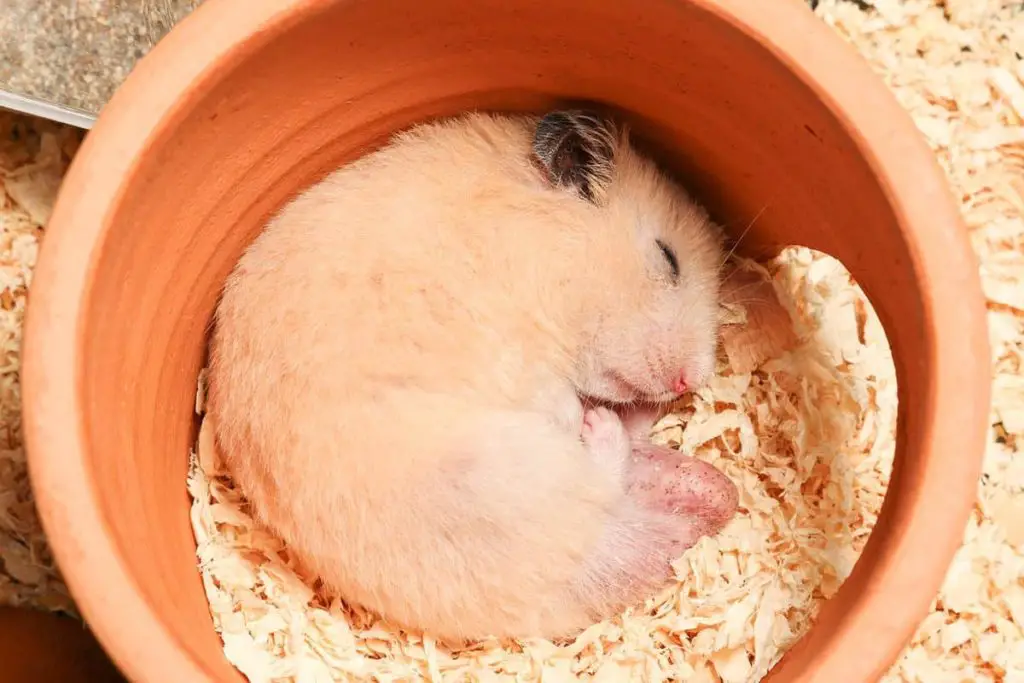Hamsters as pets are quite straightforward to care for. They have a simple diet and do not require much grooming. They’re often described as the ultimate low-maintenance pets. However, while their care might not be too complicated, there are certain things that you need to know about these little critters to give them the environment they need to thrive.
For instance, what temperature do hamsters like and need? Do hamsters like the cold, or do they prefer to be in warmer temperatures? Is there any difference in preference between the different hamster species? To figure out the answers to these questions, and many more, we’re going to take an in-depth look at the temperature requirements of hamsters. Let’s dig in!
The ideal temperature for hamsters
The temperature that’s most comfortable for hamsters is quite similar to the temperature that most humans prefer. Most hamsters do best at a temperature between 65 and 75 degrees Fahrenheit (18 to 24 degrees Celsius). If the temperature drops below or goes above that a little it won’t immediately harm or kill your hamster, but prolonged exposure to too much heat or cold is not good for them.
Temperatures that are too cold can cause your hamster to start hibernating, while temperatures that are too hot can cause your hamster to have a heat stroke, which can be lethal.
Humidity
Another aspect that’s closely related to temperature is humidity. Hamsters need a humidity level of around 40% to be most comfortable. It’s a good idea to place a hygrometer in their enclosure to check if the humidity levels are adequate. If you notice that the humidity is too low you can remedy this by placing a bowl of water in their enclosure. The evaporation from the bowl will increase the humidity in the air.
Temperature preferences of the different breeds
There are several different types of hamsters that people keep as pets. These different hamster breeds do not all originate from the same part of the world.
Winter white dwarf hamsters, for instance, are from the tundras of Siberia. Syrian hamsters, on the other hand, are from the deserts of Syria and Turkey. Because of these geographical differences, it’s not a big stretch to assume that the different hamster types need very different temperatures to be comfortable. After all, the deserts of Syria and Turkey are generally speaking much hotter than Siberia.
However, this is not really the case. There’s only a very minor difference between the temperature that Winter White Dwarf Hamsters need compared to the temperatures that other hamsters need. Generally speaking, all hamster breeds do okay at temperatures between 65 and 80 degrees.
However, it is true that Winter Whites and Campbells can be at the lower end of that spectrum while the other hamster breeds enjoy slightly warmer temperatures. Winter Whites and Campbells typically prefer temperatures between 65 °F and 70 °F (18-21 °C), while other hamster breeds prefer temperatures between 68 °F and 72 °F (20-22 °C).
The primary difference between the breeds is that winter whites and Campbell’s hamsters are capable of resisting much lower temperatures than the other hamster breeds. They can resist temperatures of -48.5 °F and -25.2 °F, respectively. However, this does not mean that they’re comfortable at such low temperatures. They can survive it for a while, but it doesn’t mean that they enjoy it or that they survive such freezing temperatures forever.
Overheating hamsters: signs, cures, and prevention
If you live in a warm climate it can happen that the ambient temperature becomes too hot for your hamster. This can have devastating consequences. Hamsters can die if temperatures are too high. According to Pippa Elliott, MRCVS, the signs that your hamster is overheating are:
- Lethargy & Increased thirst. Some of the first signs of heat stress in hamsters are slow, sluggish behavior and an increase in water intake.
- Weight loss & unwillingness to eat.
- A limp body. If you notice that your hamster is limply laying flat on its stomach this is concerning. Try blowing on its body. If your hamster trembles or twitches but does not get up it might be suffering from overheating.
If you notice that your hamster is overheating, you can take these steps to help them cool down.
- Put their cage in a cold place. Decreasing the ambient temperature is essential in helping your hamster cool down. By placing your hamster’s cage in a cold place in your house it can help them cool down.
- Use a damp towel. Placing your hamster on a damp towel can help them cool down. Do make sure that you do not use cold water and that the towel is damp, not wet. Cold water can drop your hamster’s body temperature too fast, which is dangerous.
If these things do not help your hamster cool down, make sure to take them to a veterinarian immediately. It might be a good idea to take your hamster there anyway, even if they do cool down, just for a check-up.
Of course, to prevent is always better than to cure. Some steps you can take to prevent overheating in your hamster are these:
- Do not place their cage near windows. You should never place your hamster’s cage in the sunlight, so make sure that you place their cage away from the window, in a shaded place.
- Make sure that their cage is well-ventilated. Well-ventilated wire-cages help to keep your hamster cool because they circulate the air much better than glass tanks which trap the hot air inside the enclosure.
- Keep an eye on the temperature. Knowing the temperature of your hamster’s enclosure is essential. Without it, you don’t know if the temperature is too high or too low. By placing a thermometer in their cage you’ll always know the temperature and can take action if you notice the temperature getting too high.
- Replace drinking water often. During hot days, your hamsters drinking water can become warm quite quickly. One of the ways that hamsters can cool themselves down is by drinking cold water. Make sure to replenish their water bottle with fresh, cold, water frequently if you notice that it starts getting warm.
- Use a cold tile. A small ceramic or marble tile that’s been in the refrigerator for about 30 minutes can be placed in your hamster’s cage to provide cooling for your furry friend.
Undercooled hamsters: signs & what to do

Undercooling is often not as much of a problem as overheating for hamsters because they’re more resistant to cold than to heat. Nevertheless, undercooling can happen and is definitely something that has to be avoided as well.
According to the veterinarians at Aspens Commons Animal Hospital signs that your hamster is starting to get too cold are that he might start “shivering, or lose interest in his food and water. He could also seem lethargic. If your tiny furball’s tiny feet, ears, or nose feel cold, he’s probably too chilly. Your little pal may also begin to have trouble breathing if he gets cold.”
If they are exposed to the cold for too long hamsters can enter a hibernating state called torpor. This is not good and not something they usually do in nature. They only do it when they have a shortage of food or are exposed to temperatures that are too cold for extended periods of time. They do this to preserve energy and body heat.

If you notice that your hamster shows signs of undercooling or you are getting worried because the temperature in your house is low (perhaps due to broken heating) make sure that you increase the ambient temperature to be between 68 and 72 degrees Fahrenheit as soon as possible. This might take a while, so make sure that you give your hamster what it needs in the meantime.
While you wait for the ambient temperature to increase, the most important thing is to make sure that your hamster’s cage has enough bedding and a house or hidey-hole so that they can make a warm nest. Also, move their enclosure to the warmest place of the house and avoid drafts. As long as they have enough bedding and a hidey-hole to create a warm nest your hamster should be fine. In the wild, hamsters often spend nights in freezing temperatures which they’re capable of dealing with because they create warm burrows. If they have enough bedding and a house in their enclosure this allows them to do the same thing. Do keep an eye on them though and watch for the aforementioned signs of undercooling.
If you want to help your hamster warm up, you can also hold them in your hands to share your body heat with them and wrap them in a towel. Other options include a heating pad, a space heater, or a heating lamp. However, when using one of the latter two it’s very, very important that you use a thermometer to ensure that you prevent overheating! A heating pad is probably your best bet as it allows your hamster to use it when it wants to, while also allowing your hamster to get away from it if it feels like it’s getting a little too warm. A highly recommended heating pad is the Snuggle Safe, which you can easily heat up by placing it in the microwave.
Make sure that you avoid very sudden changes in temperature when trying to heat up your hamster. For instance, do not place them on a heater or try to heat them up with a blowdryer. This sudden change in temperature will do more harm than good.
Final words
Hamsters do not like the cold but they do not like temperatures that are too hot either. The ideal temperature for hamsters is between 65 and 75°F. A small deviation from this ideal temperature for a short period of time is not a big deal but prolonged exposure to temperatures that are too high or too low can lead to overheating or undercooling, both of which can have serious consequences.
Providing your hamster with the correct temperature is one of the most important parts of being a hamster owner. Luckily, hamsters enjoy similar temperatures that we humans do, making it quite easy to give them an environment in which they can thrive!
- How Long Do American Eskimo Dogs Live? Important Factors and Care Tips - September 29, 2023
- Do American Bulldogs Need Grooming? Essential Tips and Care Guidelines - September 29, 2023
- Do Bengal Cats Enjoy Playing? Essential Tips for Keeping Them Active - September 29, 2023